Welcome to the ultimate guide on nurturing succulents, a popular choice for plant enthusiasts seeking low-maintenance yet stunning greenery for their homes.
If you’re like many plant lovers who have faced the challenge of adapting these resilient plants to less-than-ideal indoor environments, this article is your beacon of hope.
As an experienced master gardener with a passion for succulents, I’ve navigated the complexities of caring for these unique plants in various settings. Here, you’ll discover practical, step-by-step advice tailored to the needs of both novice and seasoned gardeners.
Let’s embark on this journey together, transforming your spaces with thriving succulents by mastering their fundamental care needs. Whether you’re looking to enhance your indoor oasis or create an outdoor succulent haven, this guide is the resource you’ve been searching for.
- Temperature: Ideal range is 50°F to 80°F. Avoid extreme temperatures; few can withstand freezing or scorching conditions.
- Sunlight: Some succulents need abundant light; others prefer indirect sun. North or east-facing windows are best for light-sensitive types.
- Containers: Choose pots with drainage holes. Size matters; too big can cause root rot, too small can stunt growth.
- Soil: Use well-draining soil, a mix of cactus potting mix, coarse sand, and gritty amendment like perlite or pumice.
- Watering: Implement “soak and dry” method, ensuring soil dries completely between waterings. Avoid water accumulation in the plant.
Caring For Indoor Succulents In Eight Simple Steps
| Care Aspect | Recommendations | Additional Tips |
|---|---|---|
| Temperature | Ideal range: 50°F – 80°F | Tolerates daily fluctuations; avoid extreme temperatures. |
| Sunlight Exposure | Depends on species; some prefer abundant, others indirect | North or east-facing windows ideal for light-sensitive types. |
| Container Selection | Must have drainage holes; size should match plant size | Breathable materials like unglazed clay are beneficial. |
| Soil Type | Use well-draining soil mix | A mix of cactus potting mix, coarse sand, and perlite/pumice. |
| Watering Method | “Soak and dry” or “dunk and soak”; allow soil to dry fully | Avoid water accumulation in the plant; rotate pot when watering. |
| Fertilizing | Infrequent; use half-strength succulent fertilizer | Do not fertilize during dormancy periods. |
| Pest Control | Look out for mealybugs, aphids, scale | Use insecticidal soap or diluted isopropyl alcohol for treatment. |
| Pruning and Propagating | Prune for health or aesthetics; propagate as needed | Best done in spring or early summer for vigorous growth. |
Caring for indoor succulents is surprisingly easy — if you set them up for success. That means giving them the initial environmental conditions they need to thrive and providing basic yet essential ongoing maintenance.
Get these eight steps right, and soon, your window sills are crowded with lush, happy succulents.
Temperature Needs for Indoor Succulents
You might expect plants that originate in the desert would prefer scorching conditions, but that’s not the case. Succulents appreciate and can thrive between 50°F-80°F.
If your home is warmer during the day than at nighttime, that’s perfectly fine as it mimics the natural heating and cooling cycle. But what if your home’s indoor temperature is consistent? Succulents can also tolerate it, provided the levels are within the preferred range.
However, do know that consistent indoor temperatures year-round suppress many succulents’ natural habit towards winter or summer dormancy. This means you are more likely to see slow growth year-round.
Note: Only a few succulents can tolerate freezing or scorching temperatures continuously. However, most succulents can survive if the temperature occasionally drops below forty or exceeds ninety degrees.
Sun Exposure Needs for Indoor Succulents
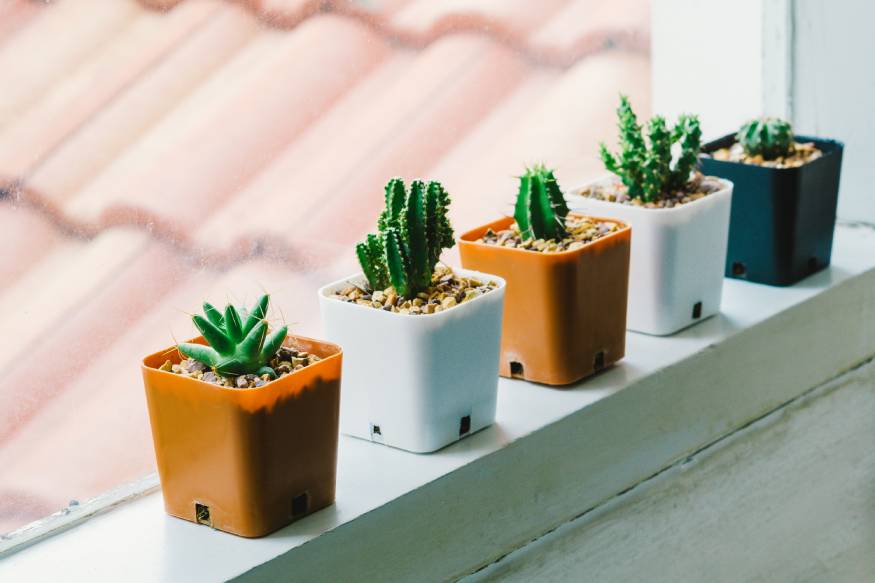
There is some variation in the preferred sun exposure for succulents. For instance, the fairy castle cactus want as much light as they can get, while others, such as aloe and string of hearts, don’t like direct sunlight.
The latter make ideal house plants because they grow best in a north or east-facing window. If you put them in a room with a south-facing window, they also don’t demand prime windowsill real estate.
Even those succulents that prefer direct sun may be fine with whatever you can offer, as long as their other needs are met. My succulents do fine in a room with only north-facing windows, but they’re big enough to provide strong, indirect sunlight all day.
Some species of succulents don’t just thrive in health when given sufficient light; they also transform.
For example, Coppertone sedum is a light green plant in most homes. If given a lot of direct sunlight, the tips of the plant turn a beautiful orange-yellow color.
The same thing happens to string of hearts. Their leaves will have a deeper green color and become more variegated. Others, like zebra haworthia, may grow flowers with enough sunlight.
If your home doesn’t provide enough light to keep your succulents happy, you can supplement with succulent grow lights or bulbs.
Containers for Indoor Succulents

You can grow most succulents in any container, whether it’s a priceless antique Kintsugi pot or a used yogurt container. Still, you should be on the lookout for two things – drainage and size.
Water trapped in a container can drown the plant’s roots, encourage root rot, attract pests, and cause other problems. So much as possible, only use a container with drainage holes.
But what about the material of the container? Is it also important? The material of the container matters less as long as it has good drainage. But if you are overwatering, breathable pots like unglazed clay can wick away moisture and allow more air circulation.
If you want a pot with no holes, there’s a simple workaround to prevent trapped water. You can put your succulent in a thin plastic pot first. When it’s time to water the succulent, you can remove the plastic pot and let it fully drain before returning it to the decorative pot.
Another substantial factor is the size of the pot. Particularly with a mounding succulent, you want your plant to have a little free space around the edges to grow. However, you don’t want to use an oversized container.
Note: A pot that is too large will stay wet for too long because there aren’t enough roots to suck up the water. Oversized pots can also encourage root growth that outpaces the plant’s growth.
In contrast, undersized pots can damage succulents by stifling their growth, and the roots tend to grow out through the drainage holes and block them.
Soil for Indoor Succulents
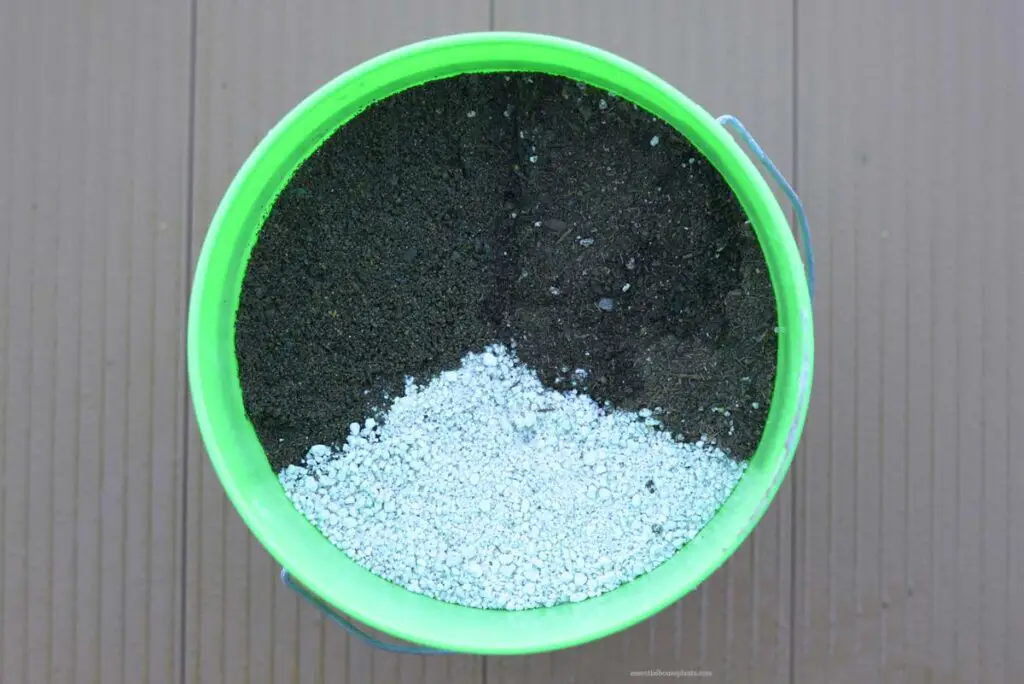
One of the most important things you can do to set your succulent up for success is to mimic their natural environment.
Well-draining soil allows you to water your succulents thoroughly without worrying about root rot or any other problems that result from overwatering.
You can use any well-draining succulent or cactus mix that includes perlite or pumice. However, I have generally found commercially available mixes full of organic material, peat or coconut coir, and too light in sand and gritty amendments.
Fortunately, making a DIY succulent soil mix is easy. It can be confusing that there are a lot of different recipes online. The truth is, most of them will probably work fine. Again, succulents are resilient plants.
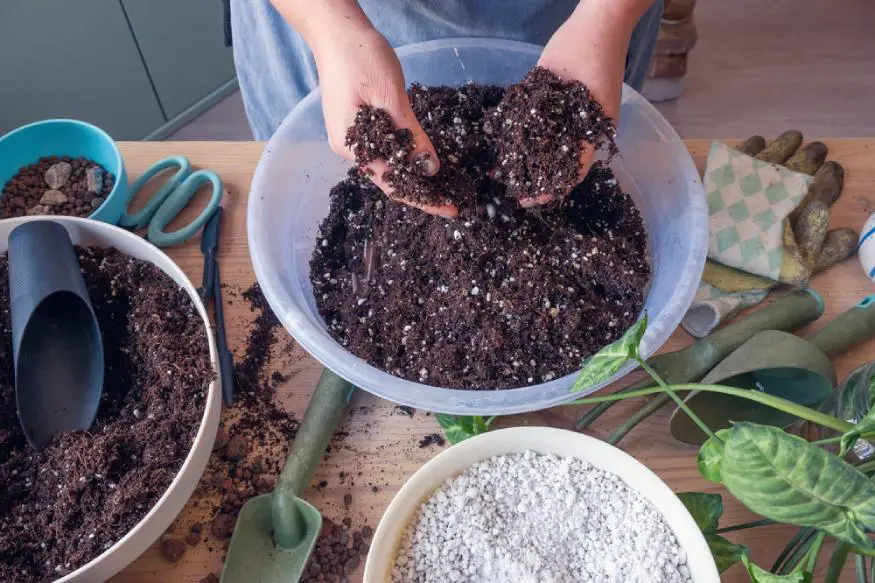
I like to use the same three ingredients whenever I need to mix up a succulent mix, but I vary the proportions based on how I want to use it.
When I want to grow succulents that thrive but are as low-maintenance as possible, I use the following mix:
- Two parts commercially available cactus potting mix,
- One part coarse sand, and
- One part gritty amendment (such as perlite or pumice).
When propagating succulents or making a resolution to be more attentive to my houseplants, I go with a mix that is even lower in organic matter.
This mix is extremely well-draining and is fine for newly propagated succulents because they rely mainly on the propagated leaf or stem for water and nutrition rather than the soil via roots.
- One part commercially available cactus potting mix,
- One part coarse sand and
- One part gritty amendment (such as perlite or pumice).
Note: Remember that the relatively low proportion of organic matter in this mix means you will need to water and fertilize more frequently.
In general, you can use these DIY potting blends for all succulents. However, a few succulents prefer more acidic soil, such as haworthia fasciata. If you have one, you may want to amend the soil to acidify it.
Water Needs for Indoor Succulents
It rarely rains in the desert environment where succulents originate, but it pours. That means they are adapted to getting very dried out, then drenched with a torrential downpour, and then drying out fully again.
You can mimic these intermittent but torrential downpours by thoroughly watering and then letting the soil dry out entirely between waterings.
We recommend the “soak and dry” and the “dunk and soak” methods.
Note: Avoid dripping water into the plant. Water can get trapped and cause rot.
Whenever you water the plant, rotate the pot as well. Doing so will help your plant grow up straight instead of reaching in the direction of the light.
Fertilizer Needs for Indoor Succulents
If you have a good proportion of organic matter in your potting mix, you can get away with infrequently fertilizing your succulents.
You can even probably maintain a healthy succulent without fertilizing, provided that you repot every few years to ensure the beneficial organic matter is still available to your plant.
If you want your succulents to thrive and not just survive, you’ll want to get on a feeding schedule. Luckily, succulent fertilizer needs are low so it won’t be much of a hassle.
We recommend using an organic fertilizer. Ideally, go with an option designed specifically for succulents and use at the recommended concentration.
If you use an organic option not marketed for succulents, dilute it to half the strength described in the package instructions.
Do not fertilize your succulents during dormancy (not growing). It is usually around winter for most succulents; however, some skip their dormancy period if they are in a warm, sunny spot. Also, some succulents have a summer dormancy period, but typically only when grown outdoors in a hot growing zone.
Pests and Indoor Succulents
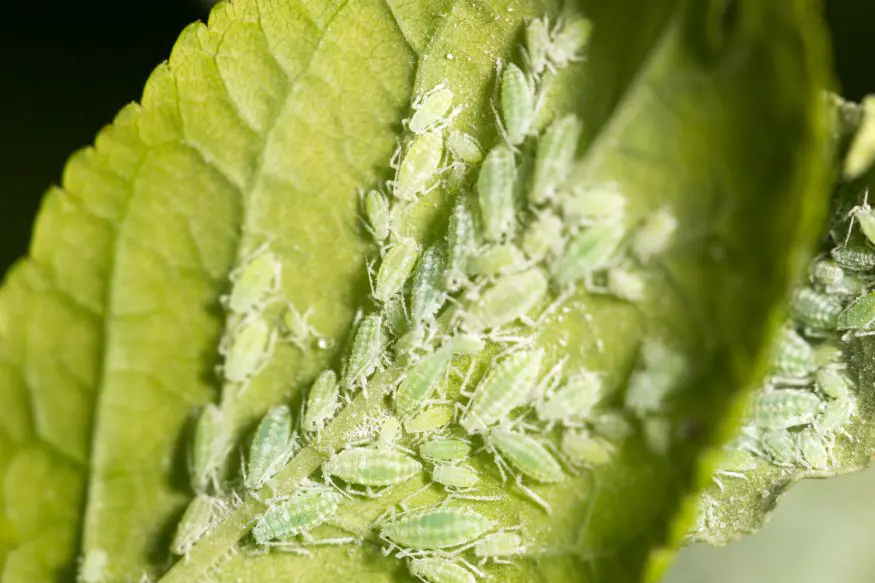
Overwatered succulents are more susceptible to pest attacks because their roots are already compromised. Overwatering also encourages insect activity within the soil. Here are three pests that affect indoor succulents:
- Mealybugs look like crumbs and tend to live in a white web-like substance inside the nooks and crannies of your succulents.
- Aphids are small green bugs that munch on your plant and leave “honeydew” (sugary excrement) on the leaves. Honeydew attracts ants and can grow black mold.
- Scale also infests some succulents. They are flat insects with an armor-like hard upper shell. Technically, mealybugs are another scale species, but when people say scale, they generally mean this hard-backed scale. Like aphids, scale leaves sticky honeydew residue on the plant’s leaves.
Caring for infested plants
The best offense is a good defense. Keep your plants healthy, segregate any plants with pests immediately, and your succulents are unlikely to be infested in the first place.
- Scrape them off: Scale insects don’t move, so you can wipe or scrape them off a plant’s leaves. Unfortunately, they can quickly come back unless you pick off each one from the infected plant.
- Wash the plant: You can’t remove mealybugs and aphids individually as quickly as you can with scale. However, simply washing the plant with a strong spray of water can be enough to eliminate a mild infestation or mitigate a bad outbreak.
- Use soapy water: Cleaning the plant with lightly soapy water can also help (and will eliminate the sticky residue). It’s better to use insecticidal soap, Castille soap, or another pure soap rather than a soap blended for other purposes (like hand soap or dishwashing soap).
- Kill them by hand: If you only have a few mealybugs, aphids, or scale, you can try killing them by hand. Use a little isopropyl alcohol (full strength) on a Q-tip, and swab away the brigands.
- Consider spraying chemicals: Spraying your plant with chemicals (organic or not) is always a bit more of a crapshoot. Some reputable sources speak to the efficacy and safety of different pesticides, while others report damage to plants from the same ingredients.
If you are considering spraying chemicals, spray just one leaf at first as a test. If the leaf seems unaffected after a week, you can go on to spray the rest of the plant.
Note: The best spray options are isopropyl alcohol, neem oil, insecticidal soap, or some combination, typically diluted with water.
For example, some gardeners use isopropyl alcohol full strength. However, we recommend diluting alcohol first (50/50 water and alcohol).
If there is no damage to the plant and the infestation is not resolved, that’s the only time you should consider a more potent mixture. The Missouri Botanical Gardens recommends a mixture of one cup of isopropyl alcohol, one tablespoon of insecticidal soap, and one quart of water.
Pruning, Propagating, and Repotting Indoor Succulents
Growing up, my father loved to remind me of the slogan he called the Five Ps: Prior preparation prevents poor performance. That’s true when it comes to succulents.
A succulent in an appropriate pot full of well-draining soil, sitting in a sunny windowsill, appropriately watered and fertilized, is a recipe for peak succulent performance.
Most of the time, that’s all your plant needs. But occasionally, your plant will benefit from one of the Three Ps of succulents: pruning, propagating, and (re)potting.
Pruning
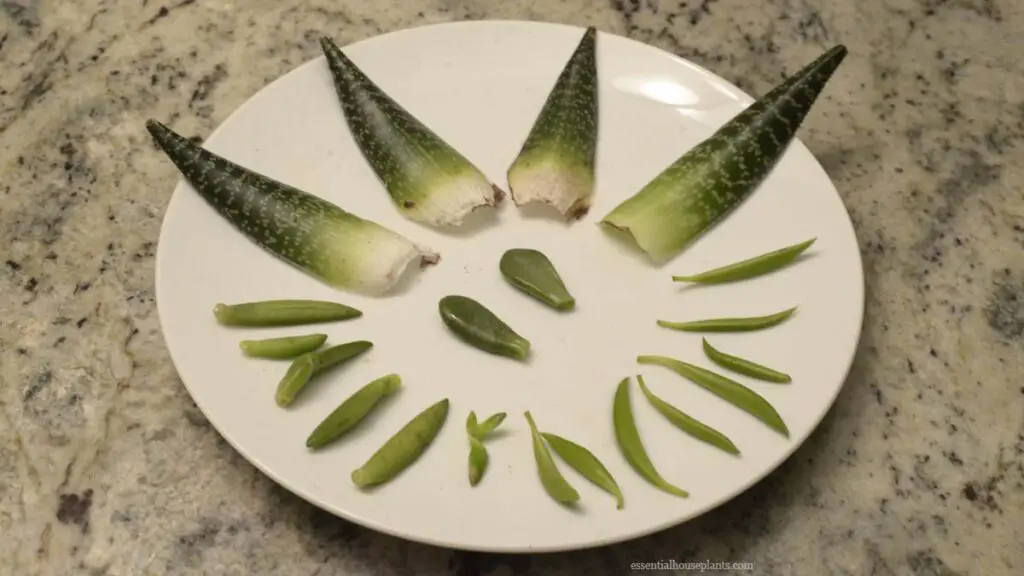
There are four main reasons you might need or want to prune your succulent: (1) harvest, (2) aesthetics, (3) maintenance, and (4) propagation.
Succulents like aloe don’t require any pruning, but some people harvest branches to use the gel inside the leaves to treat burns or in a smoothie.
Other succulents like the Elephant bush can be pruned and trained to grow in a particular shape. Aside from aesthetic reasons, you can also prune to remove dead leaves and diseased pieces.
The last reason, propagation, is probably the most common reason for pruning a succulent. You might prune because you want to propagate multiple baby plants. However, you might want to prune and propagate your succulent to make the original succulent more appealing.
For example, if your succulent didn’t get enough sunlight and has grown sparse and leggy, you might want to behead the plant and propagate the top to create a shorter, more compact plant.
You can prune indoor succulents any time of year if necessary. However, the ideal time is to prune in the spring or early summer, when the plant begins its most vigorous growth.
- When you prune, use a sharp, clean, sterile knife or fine pruning shears. Wipe your gardening knife with isopropyl alcohol before you prune each plant to ensure you don’t spread any plant diseases.
- Gloves aren’t generally necessary, but you should wear them if you are pruning euphorbia plants, which contain a toxic milky sap that can cause skin irritation.
- Cut leaves or branches off flush with the stem. At these joints is a material called meristem tissue. These cells function like stem cells, helping to propagate (reproduce) the plant.
You want the cutting to have some of the meristem tissue, but you also want to leave behind the meristem tissue in the stem (as opposed to leaving a crater in the stem).
Remember that if you prune off a branch, it will likely send up one or more new branches from the same spot. Echeveria is a good example.
If you want it to grow in a specific shape, strategically prune off pieces to stimulate the growth of branches where you want them.
Propagating
Propagation is a cheap and surprisingly easy way to have an abundant succulent collection you can share with others. Plus, various ways of propagating your succulents include leaf cuttings, stem cuttings, and offsets.
Check out our comprehensive guide to propagating succulents for more information.
Potting
You should repot succulents every two to three years. The low proportion of organic material in their potting mix means they benefit from fresh potting mix every few years, especially if you’re not great about remembering to fertilize.
The other main reason to repot your plant is if it has overgrown its container. If it fills the entire top of the pot or roots are growing out of the drainage hole, it’s a good sign you need to upgrade to a larger container.
Note: Spring is the best time to repot, before the major growth season. However, most healthy indoor succulents can tolerate being repotted any time of year as long as you handle them gently.
Caring For Outdoor Succulents In Eight Simple Steps
| Care Aspect | Recommendations | Additional Tips |
|---|---|---|
| Temperature | Thrives between 50°F – 80°F | Most can’t tolerate frost; some varieties handle mild frost. |
| Sunlight Exposure | Varies; some need full sun, others prefer partial shade | Adjust location seasonally for optimal sunlight exposure. |
| Container Selection | Use pots with good drainage, especially in cold zones | Pots allow for moving succulents indoors during extreme temperatures. |
| Soil Type | Nutrient-rich, well-draining soil | Amend with compost, coarse sand, perlite, or pumice. |
| Watering Method | Mimic natural rainfall; infrequent but thorough | Water less in winter; ensure soil dries between waterings. |
| Fertilizing | Half-strength application a few times a year | Ground-planted succulents generally don’t need extra fertilizer. |
| Pest Control | Be aware of specific outdoor pests like cactus moths | Healthy plants are less likely to get infested. |
| Pruning and Propagating | Prune for shape; natural propagation is common | Pruning can help maintain desired plant structure and health. |
Not everyone can grow succulents outdoors, but they are a great addition to your garden if you’re in the right growing zones. They have minimal to no need for irrigation, thrive in soil that would challenge other plants, and self-propagate to help fill space in your landscape.
Temperature Needs for Outdoor Succulents
Most succulents thrive in temperatures from fifty to eighty degrees Fahrenheit, although they can typically tolerate weather swings of ten to fifteen degrees above and below that range.
However, most succulents cannot tolerate even a mild frost. That’s why most succulents can only be grown outdoors (year-round) in USDA growing zones 9+. However, it often works well in cooler growing zones to keep succulents outdoors during the warm seasons and move them inside for the winter.
In the winter, most plants will go into dormancy, in which their growth slows or stops altogether. If the temperature exceeds ninety in the summer, some succulents will “burn” and enter a summer dormancy period.
Some succulents can be more cold-tolerant than others. My grandmother had a hens and chicks plant, sempervivium, that survived on a stump by the garage for over forty years.
That was in Indiana, zone 6A, where they usually get snow. Sedum is also known for being relatively frost-hardy compared to other succulents.
Sun Exposure Needs for Outdoor Succulents

It is crucial to identify the sun needs of your specific succulent.
Some succulents, such as cacti, want full direct sunlight for as many hours of the day as possible. Others like echeveria prefer full sun but are willing to compromise (for example, an area of morning shade and direct afternoon sunlight). Others, like zebra haworthia, grow naturally under the canopy of other plants, so they prefer dappled sunlight or morning sunlight and afternoon shade.
Note: Giving a sun-loving succulent too much shade will stunt and weaken its growth. Giving too much sun to a shade-loving succulent can give it a sunburn.
Growing outdoor succulents in pots is an excellent option because you can move the container around to find the best place and adjust to account for seasonal changes in sun exposure.
Too much sun can stress out your succulents, but it can be good for other succulent species.
For instance, coppertone sedum responds to excess sunlight by changing colors — the green leaves develop attractive red and yellow tips. Some people like to move indoor succulents outdoors during the summer to give them enough sunlight to provoke these color changes, then bring them inside for the cooler months.
Containers and Other Options for Outdoor Succulents
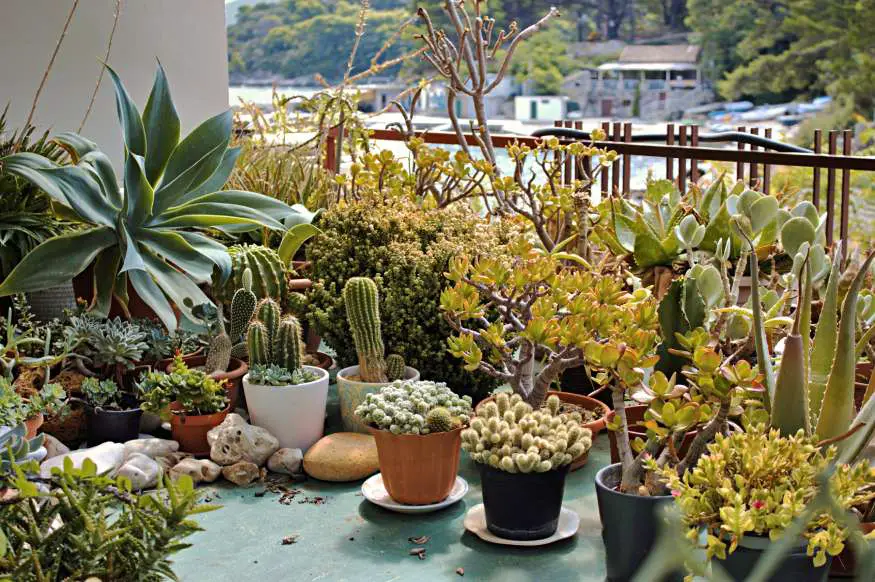
If you want outdoor succulents but live in a growing zone with winters too cold, you’ll need to grow them in pots. That way, you can leave them outside while the temperature is suitable and bring them indoors when the weather drops below fifty or exceeds ninety.
The right pot for an outdoor succulent is the same as an indoor succulent: any appropriately sized pot with good drainage. Outdoor plants are susceptible to root rot and other problems without good drainage.
If you’re right on the edge of an appropriate growing zone and don’t want to use a pot, you can try growing some of the more cold-hardy succulents. Sempervivum (hens and chicks) and sedum are best known for tolerating cold.
If you live in zone ten or higher, you have more options. You can plant succulents directly into your landscape. They look great planted in the ground, and succulents with a trailing growth pattern look particularly great in the crevices of a rock wall.
Soil for Outdoor Succulents
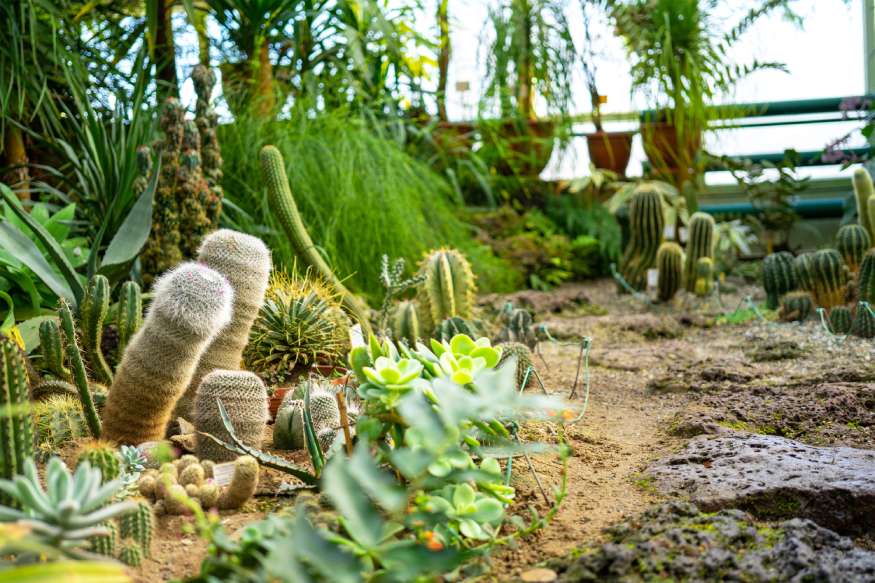
Provide nutrient-rich, loose, well-draining soil for your outdoor succulents. Sandy and rocky soil is ideal but may need to be enriched with compost. Amend your soil to add grit for more drainage as required.
Note: Clay soil is not suitable for succulents or pure compost.
You can use the same amendments for indoor potting mix, including coarse sand, perlite, pumice, gravel, or pebbles.
Most succulents have relatively shallow roots, so you don’t need to amend more than six inches of soil. You can use larger landscaping rocks, like lava rocks, to further increase drainage.
Succulents tend to prefer slightly acidic soil, some more than others. You may need to acidify your outdoor succulent garden. Keep in mind that acidified soil limits your options for companion plants.
Some people like to plant succulents on small mounds to prevent water accumulation. Ideally, plant succulents into moist soil and then don’t water again for the next week.
Water Needs for Outdoor Succulents
In the native habitats of most succulents, it rains infrequently but heavily. Your best bet is to try to replicate that.
That means if it rains, you should skip watering that week. In a dry summer, you might water once a week, while you might not water at all in a wet winter.
Fertilizer Needs for Outdoor Succulents
Like indoor plants, you should also fertilize outdoor potted succulents. A half-strength application a few times a year, in the spring and summer, is plenty.
Succulents planted in the ground generally won’t need fertilizer. They are such slow feeders that the soil will likely replenish its nutrient content adequately from fallen leaves and natural compost.
If you do want to fertilize, go with an organic liquid fertilizer. Either go with a succulent-specific option or dilute to half-strength. Earthworm castings and compost tea are good options.
Pest Care for Outdoor Succulents
In some ways, pest care outdoors is a little more complicated than for indoor succulents. For one thing, you need to be careful of beneficial insects. Beetles, bees, and wasps may be attracted to your succulents’ flowers, and leafhoppers or spiders might nest in your succulents, which is fine for your plants.
Insects like aphids and scale can infest indoor or outdoor succulents. However, there are other insects you only need to worry about outdoors. The cactus moth (Cactoblastis cactorium) and leaf-footed bugs (Hemiptera: Coreidae) are examples.
In another way, pest care for outdoor succulents is simpler than indoors. Healthy plants are unlikely to become hosts for pests, but if pests get a foothold beyond an individual plant, there probably isn’t much you can do.
Pruning and Propagating Outdoor Succulents
Many outdoor succulents propagate themselves. Some create offsets connected to the host plant while others grow new sets of roots from places the stem contacts the ground. Some species can even propagate themselves using natural leaf or stem cuttings.
A leaf that falls off and drops to the soil next to the plant may grow a new plant.
However, you can prune your outdoor succulents to preserve the desired shape. You can also propagate succulents in the traditional ways (leaf cuttings, stem cuttings, and offsets).

